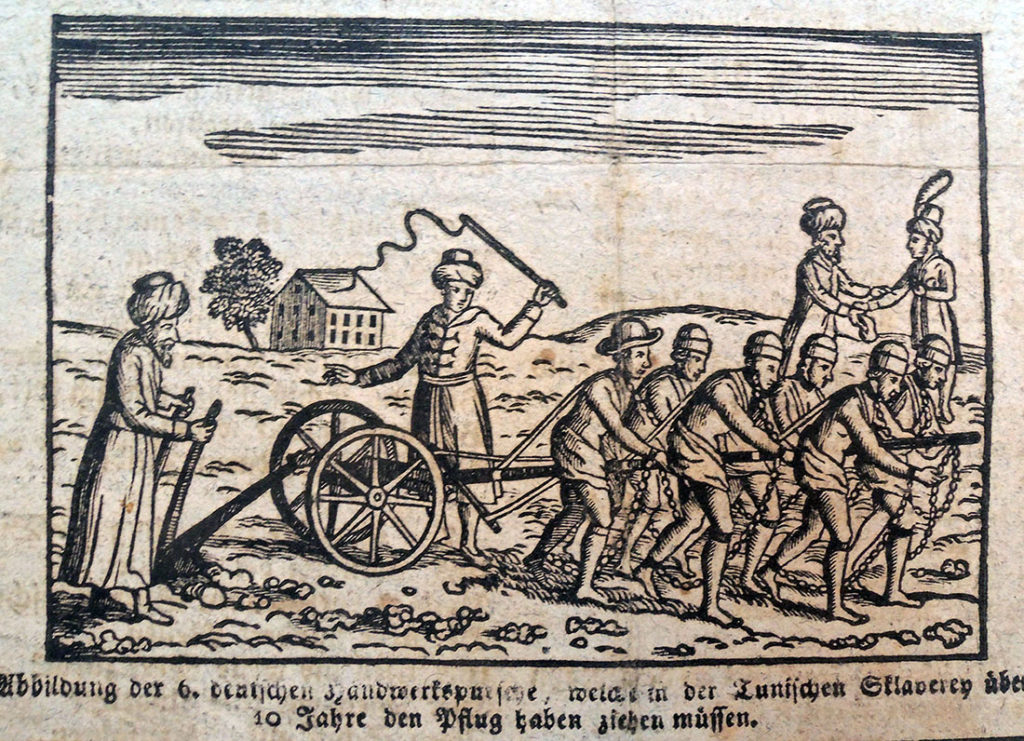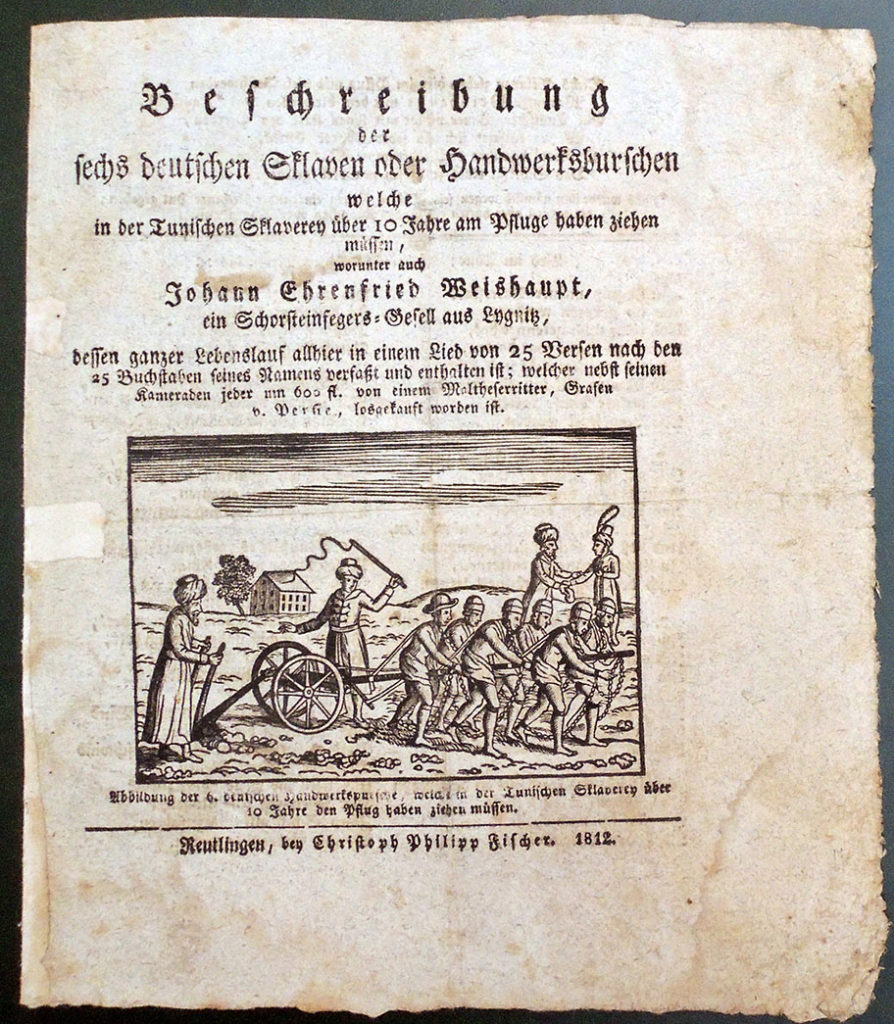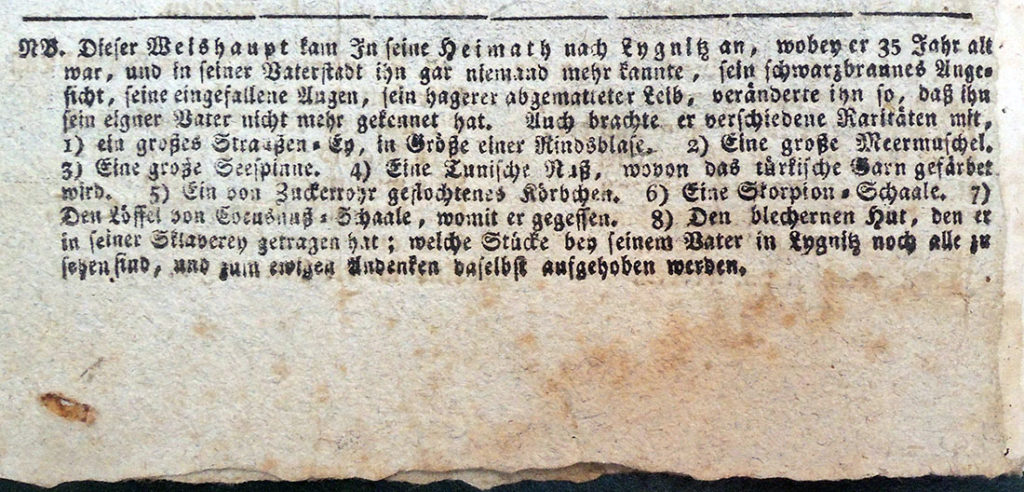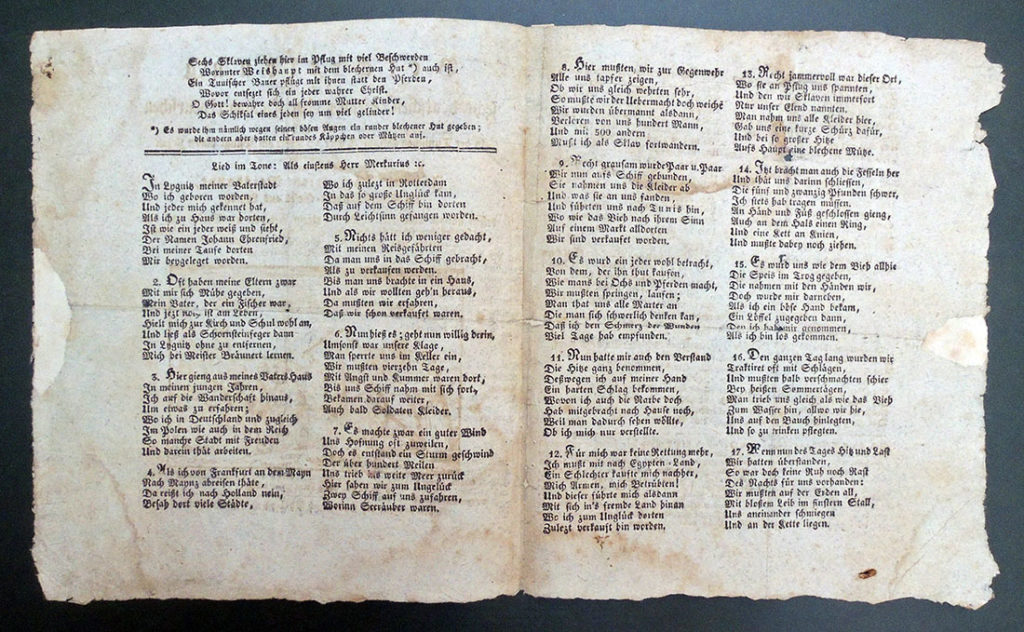 On the title page of this 1812 ballad is a woodcut depicting six Germans pulling a plough while turbaned slave owners harass them. In the top right, a nobleman pays for their release, including Johann Ehrenfried Weishaupt who might be the one slave with a different hat.
On the title page of this 1812 ballad is a woodcut depicting six Germans pulling a plough while turbaned slave owners harass them. In the top right, a nobleman pays for their release, including Johann Ehrenfried Weishaupt who might be the one slave with a different hat.
 Beschreibung der sechs deutschen Sklaven oder Handwerksburschen welche in der Tunischen Sklaverey über 10 Jahr am Pfluge haben ziehen muessen, worunter auch Johann Ehrenfried Weishaupt ein Schornsteingfegers-Gesell aus Lygnitz, dessen ganzer Lebenlauf allhier in einem Lied von 25 Versen … [The Description of Six German Slaves or Craftsmen Who Had to Pull on the Plow in Tunisian Slavery For Over 10 Years, Among Them Johann Ehrenfried Weishaupt a [?Schornsteingfegers-Gesell] from Lygnitz, Whose Whole Life Is Told Here in a Song With 25 Verses …] Reutlingen, bey Christoph Philipp Fischer, 1812. Graphic Arts Collection GAX 2018- in process
Beschreibung der sechs deutschen Sklaven oder Handwerksburschen welche in der Tunischen Sklaverey über 10 Jahr am Pfluge haben ziehen muessen, worunter auch Johann Ehrenfried Weishaupt ein Schornsteingfegers-Gesell aus Lygnitz, dessen ganzer Lebenlauf allhier in einem Lied von 25 Versen … [The Description of Six German Slaves or Craftsmen Who Had to Pull on the Plow in Tunisian Slavery For Over 10 Years, Among Them Johann Ehrenfried Weishaupt a [?Schornsteingfegers-Gesell] from Lygnitz, Whose Whole Life Is Told Here in a Song With 25 Verses …] Reutlingen, bey Christoph Philipp Fischer, 1812. Graphic Arts Collection GAX 2018- in process
The Graphic Arts Collection recently acquired a very rare first edition of this ballad, which we are told was performed at fairs singing to the tune of Als einstens Herr Merkurius. The anonymous author used as his source text the self-published story of the apprentice chimney sweep Johann Ehrenfried Weishaupt who was abducted and spent ten years as a slave in Tunisia before being freed by a Maltese nobleman, returning to his native village in Silesia. The source text is also very rare: Beweinungswürdige Schicksale Johann Ehrenfried Weishaupt aus Liegnitz in Schlesien. Von ihm selbst aufgesetzt, first published 1789, with a second edition in 1795. No copies can be found in the United States.
Th printed ballad is also a type of acrostic, with the first letter of each of the 25 verses spelling out Johann Ehrenfried Weishaupt’s name, the subject of the narrative.
 The pamphlet has a long printed note at end, which tells the reader that when he returned, Weishaupt set up a small cabinet in his father’s house with the curiosities from his time in the Middle East: an ostrich egg; a large sea shell; a large spider crab; a ‘Tunisian’ nut from which the Turks derive color; a basket woven from sugar cane; the shell of a large scorpion; the curiously shaped spoon from which he ate while in captivity; and the curiously shaped metal hat he was forced to wear. I’m told the curiosity cabinet can still be inspected but I haven’t been able to find a reference online.
The pamphlet has a long printed note at end, which tells the reader that when he returned, Weishaupt set up a small cabinet in his father’s house with the curiosities from his time in the Middle East: an ostrich egg; a large sea shell; a large spider crab; a ‘Tunisian’ nut from which the Turks derive color; a basket woven from sugar cane; the shell of a large scorpion; the curiously shaped spoon from which he ate while in captivity; and the curiously shaped metal hat he was forced to wear. I’m told the curiosity cabinet can still be inspected but I haven’t been able to find a reference online.

